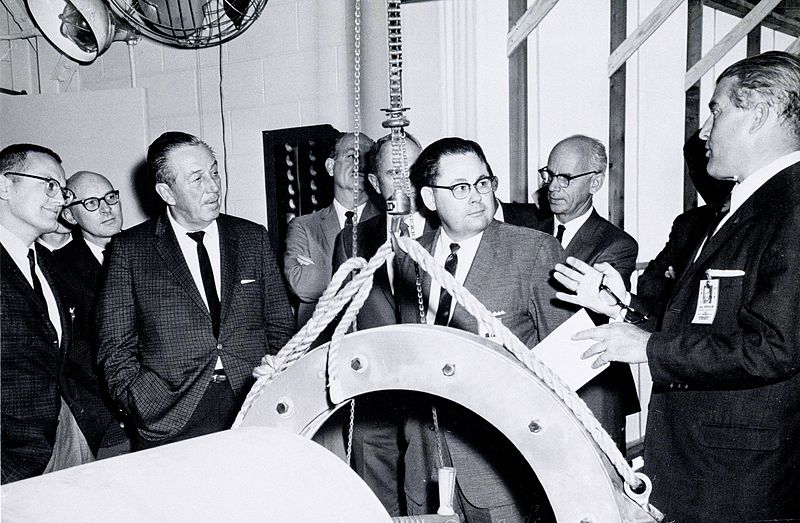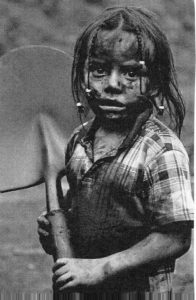Families throughout the United States faced hard times during the late-1930s. People were still recovering from the effects of the Great Depression, unfulfilled promises from President Roosevelt’s New Deal, and unemployment.1 During these financially troubled times, two dreamers, brothers Roy and Walt Disney, were on a mission to continue to produce quality animation on a fixed budget. After Fantasia‘s disappointing initial grossing, Disney Animation Studios’ debt was edging toward $3 million, which led to Walt Disney cutting all of his animators’ salaries. Although Roy Disney believed that this would undermine everything the two had built, he realized the only alternative was to sell their films through a franchise or file for bankruptcy, and so he agreed to the arrangement, unaware of the wrath that would follow.2

Tensions rose as animators also noticed a change in Walt Disney’s attitude toward them. The once cheerful man who was full of magic soon lost that touch, becoming distant to the people around him. Walt began to take all the credit for the animations that were being produced, and his employees soon realized that their pay was much lower than Disney’s salary. His ‘in-betweeners’ and clean up men were making $20 at the most, while his animators, ranging from amateurs to professionals, made between $75 and $300 weekly. Walt brought home a salary five times what his highest paid animators were bringing home.3
These pay disparities led his beloved animators to walk out on the company. On May 28, 1941, employees were greeted by hundreds of their coworkers waving signs preventing them from entering the studio. Although the exact number of employees who went on strike differs between sources, it is estimated that roughly one-third of the 1200 employees went out that morning. For the first few days of the strike, employees exchanged jokes and banter. The animators held up picket signs with clever illustrations that depicted their true emotions. One that struck deep to the studio was a picture of Walt Disney’s face in a cartoon style with crossed eyes and the caption “I can’t see why they’re unhappy.”4 Walt refused to give in to the demands of his employees, because he did not feel that they needed the increase in pay. This firm stance left the strike to go on for five whole weeks, tearing apart the company’s unity. This tension led Walt to leave for South America to take some time away from work, while he let go almost half of his team. After a bank representative for the company stepped in to review the case, the studio was sustained in favor of the animators leading to the dispute being settled. Though a treacherous three and a half months had passed, work finally resumed at the studio in Burbank, California with 694 employees on September 16, 1941.5

Just as everything seemed to be falling into place, the unimaginable happened. On December 7, 1941, the Japanese Navy Air service struck down on the United States naval base in Pearl Harbor sending the United States into World War II. Panic set in for the animators again as the cost of the films being produced during this time put a damper on the company’s overall budget.6 During this time, Walt and his company were sought out to produce cartoons for the armed services as morale builders. They also used half of the animation studio to house antiaircraft troops that were fighting during World War II. Although the company seemed to be taking on too much, this engagement would inspire Walt to create a few propaganda short films and war posters of his own that would speak to the people of the United States. Of all of the animation produced during the war, the most notable piece was Der Fuehrer’s Face, an animated short film in which Donald Duck dreams he is working in a German factory, all while ridiculing Adolf Hitler. The combination of housing troops in the studio, producing short films that expressed the idea of America’s freedom, and the efforts to inspire those fighting for the United States broaden the brand as a whole, showing every single American know what the Disney company stood for at the time.7
Though Walt himself did not find very creative success regarding his work toward the government propaganda animation and posters, it paid off very well for the company, raising its reputation and generating profits. The animation studio’s contributions to America during the World War II brought smiles with their comedic satire to families struggling to find hope as their loved were out serving their country. Soon after, they produced notable works such as Bambi (1942), Song of the South (1946), and Cinderella (1950), with Cinderella generating enough gross profit to pull the company out of debt and further establish their brand. Had both the strike and Walt lending a hand during the war not happened to the Walt Disney Animation Studios, Walt and Roy Disney may not have been able to sufficiently pay their ‘on the edge of leaving the company’ employers and the bills that came with owning the animation studio. The studio itself could have shut down permanently, never transforming from two passionate brothers’ project to a multi-billion dollar brand that brings magic fans and families all across the globe.
- The Hutchinson Unabridged Encyclopedia with Atlas and Weather Guide, 2018, s.v. “The USA in the 1930s.” ↵
- Neal Gabler, Walt Disney: The Triumph of the American Imagination (New York: Knopf, 2006), 350-351. ↵
- Neal Gabler, Walt Disney: The Triumph of the American Imagination (New York: Knopf, 2006), 355. ↵
- Steven Watts, The Magic Kingdom: Walt Disney and the American Way of Life (Boston: Houghton Mifflin, 1997), 209 ↵
- Neal Gabler, Walt Disney: The Triumph of the American Imagination (New York: Knopf, 2006), 367-371 ↵
- Barry Keith Grant, “Walt Disney Company,” Schirmer Encyclopedia of Film, Vol. 4, (New York: Schirmer Reference, 2007), 331-336. ↵
- Paul Lagasse, “Walt Disney,” The Columbia Encyclopedia, 8th ed. (Columbia: Columbia University Press, 2018) ↵



94 comments
Amanda Quiroz
As a person who grew up watching a lot of Disney movies, this grabbed my attention. I can’t believe the company almost went out of business! I never knew that he produced propaganda for the government during the War until I read this article. The studio could have been shut down for good if he hadn’t gone through with it. It was very beneficial to both the company and the War.
Makenzie Santana
It’s crazy that if there was no World War 2, Disney would have went out of business and none of the animation films that everyone loves and adores today wouldn’t have been made. Disney and the War times both benefited from each other as Disney brought smiles, support, and hope while the war had brought them profit for the role they played in it. I had no idea that Disney’s animators went on strike for not being payed enough and the type of strain it put on the company, but I am happy that the company went in the direction that it did and made that kind of impact.
Danniella Villarreal
It is surprising to know that there were financial problems, and I am a huge fan of Disney movies but I never read about Walt Disney himself. I never knew Walt Disney played a part in producing propaganda to boost soldier’s morale. This was a very interesting and well-written article.
Christopher Metta Bexar
I can believe that the studio had financial problems around 1939 and 1940. Snow White and Fantasia were two of the most expensive animated films in history ( cost adjusted for inflation). Spending a reported two million dollars to produce Snow White at a time when movie tickets sold for 25 to 35 cents was a large gamble.
Walt Disney was always a careful man with money but I believe the article failed to illustrate that he learned his lesson from the strike and kept this employees happy after that. Disney last I heard has some of the most satisfied employees in the industry, both financially and benefitswise.
Katherine Wolf
It is crazy to think that the money-making monster that Disney is today started out in debt of $3 million dollars. It goes to show that what Walt and Roy Disney had was special. I don’t think that a lot of people know how influential the character Donald Duck was during WWII. The army actually gave Donald a special rank to thank him for his service afterwards. One of the reasons Donald acts like he does is because he was in combat and has shell shock.
Ruben Basaldu
I knew for the most part that Disney was making cartoons during WWII to boost the morale of troops and other people during that time but I had no idea that Disney was having trouble paying its own employees. It is most likely because I think of Disney as a super successful company that could never be in debt $3 million dollars but that is now and not back then.
Maria Martinez
The Disney brand today would have never led me to believe that Walt Disney himself was the source of such hard times for the company back in the 30s. It is a bit saddening to think that the founder of such an inspiring company was so money driven when starting off, seeming to dismiss his employees feelings and financial well being. Another thing that I found interesting is the fact that the company went through an era of producing war propaganda, it is crazy to think that such serious matters were displayed in cartoon form with characters that are now considered to be more targeted towards children.
Sarah Uhlig
I remember seeing replays of the propaganda that Disney had created, but I figured that Disney would take home more money that his other employees. It is a grand company that he runs and it would sadly make sense that the people who aren’t do the big jobs for the productions would get paid significantly less. It seems that those in power behind the big, happy productions are either really good people or good people with personalities that just want the money.
Noah Wesolowski
Because of how successful Disney is now I did not know that they had trouble back in the 1930s. It is very surprising that a large amount of the employees went on strike. But after reading I see their reason for it, Walt cutting their pay and taking the credit and cash for himself would have made any employees go on strike.
Ava Rodriguez
I have always loved Disney but I had no idea he took a part in promoting propaganda during the second world war. I also have not ever heard anything about the strike that took place because he was unable to fully pay them. I am extremely grateful for the movies that we have today. I just am really surprised that I have not heard anything about the negative things Disney has done.